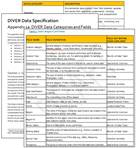DATA SPECIFICATIONS

ENVIRONMENTAL DATA STRUCTURE
Environmental data are organized by data category:
- Samples: Collection data and analysis results for discrete samples;
- Bioassay: Results from field and laboratory-based bioassay studies;
- Instruments: Packages of data from CTDs or other oceanographic instruments;
- Field Observations: Observations and measurements from field studies;
- Telemetry: Position tracks and related data for tagged animals; and
- Photographs: Field photos with GPS location and keywords.
Each data category contains a set of fields necessary to describe that data. Some common fields, like date and coordinates, appear in multiple categories (see diagram). Fields that appear in every environmental data category are known as core fields and form the fundamental relationships across data categories.
In DIVER, queries across multiple data categories return and map information at the core fields level (also called “Overview”). In these cross-category queries, data category-specific fields are available as related downloads. For queries within a single data category (e.g. Samples or Field Observations), the data table and maps will present a wider set of fields specific to that data category.

PROJECT & PLANNING STRUCTURE
DIVER Project & Planning data are oriented toward restoration planning and implementation. Each project is assigned a Project ID. Descriptive fields such as the project's name, phase, location, type (i.e., planning or project), and the activity under which the project is being undertaken are associated with the Project ID. Field definitions are provided in DIVER metadata. Project and Planning data from the restoration activities associated with the Deepwater Horizon oil spill, including locations, project status, funding, and monitoring activities, are currently available in DIVER Explorer or the DWH Trustee Council website.
